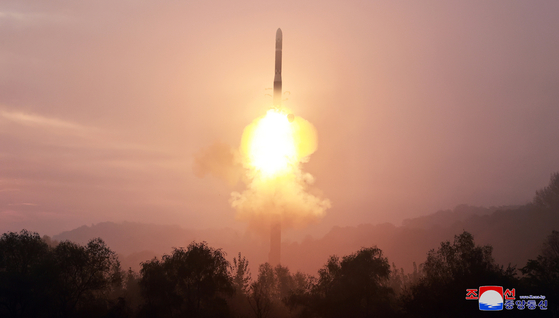South Korea’s defense minister told lawmakers on Monday there were no signs that the North tested a new rocket engine before launching the Hwasong-19 intercontinental ballistic missile (ICBM) last month, raising suspicions that it received technical assistance from Russia amid mounting military cooperation between the two countries.
Speaking at a meeting of the National Assembly’s Defense Committee, Defense Minister Kim Yong-hyun said that “signs of the North conducting an engine test were not detected” and that the possibility that Moscow provided Pyongyang with the technology to leapfrog development of the new ICBM “could not be ruled out.”
Launches of previously untested missiles by the North have typically been preceded by announcements from its state media about combustion tests for new engine systems.
South Korean and U.S. military intelligence have also discerned whether the North tested new propulsion systems through satellite images of the regime’s Sohae Satellite Testing Ground in Dongchang-ri, North Pyongan Province.

However, South Korean military intelligence said it detected no such signs ahead of the launch of the Hwasong-19 ICBM, which the North’s state media described as the “ultimate” addition to its long-range missile series.
The last test detected by the South’s military took place on March 20, when the North’s state media said the regime had conducted a ground test of a solid-fuel engine for a new type of intermediate-range hypersonic missile.
![The 11-axle transporter erector launcher used in the launch of the Hwasong-19 intercontinental ballistic missile is seen in this photograph released by the North's state-controlled Korean Central News Agency (KCNA) on Nov. 1. [YONHAP]](https://koreajoongangdaily.joins.com/data/photo/2024/11/11/6a164884-e0ec-4a5f-9d8c-57b944fa3226.jpg)
Photos released by Pyongyang’s state media showed that the Hwasong-19 was fired from an 11-axle transporter erector launcher (TEL). By comparison, the Hwasong-18 ICBM first tested in April last year was launched from a nine-axle TEL.
According to Rep. Yu Yong-weon of the conservative People Power Party, Seoul’s Defense Intelligence Agency (DIA) issued a report assessing the Hwasong-19 as a “new type of ICBM that is different from the Hwasong-18 ICBM” based on “the increase in the length and diameter of the missile’s fuselage and enhanced maximum altitude.”
According to Pyongyang’s state-controlled Korean Central News Agency, the Hwasong-19 reached an altitude of 7,687.5 kilometers (4776.8 miles) and traveled 1,001.2 kilometers over 85 minutes and 56 seconds. Both its peak altitude and flight time exceeded previous records set by North Korean ICBMs.
In its report, the DIA said the possibility of the North receiving support from Russia “regarding technologies that can be applied to the development of ballistic missiles under the guise of ‘space technology cooperation’ cannot be ruled out.”
At his first summit with North Korean leader Kim Jong-un in September last year, Russian President Vladimir Putin hinted that Moscow might be willing to lend technical assistance to Pyongyang’s space program as the two regimes pledged to deepen their ties.
Following their second summit in Pyongyang in June, where the two leaders signed a so-called comprehensive strategic treaty that included a mutual defense clause, Kim has alarmed South Korea and NATO by deploying troops to Russia, where they are expected to join the fight against Ukraine.
According to U.S. and Ukrainian officials who recently spoke to Western media outlets, Russia has amassed a large force of 50,000 troops, including a large contingent of North Koreans, to carry out an assault on Ukrainian positions in the Kursk region of western Russia in the coming days without having to relocate troops from eastern regions of Ukraine.
Sabrina Singh, the deputy Pentagon press secretary, said on Thursday that Washington “fully expects” the North Korean soldiers “could be engaged in combat.”
South Korean intelligence believes that the 10,000 troops sent by the North have been drawn from the Korean People’s Army’s 11th Corps, which comprises the regime’s special operations forces.
BY MICHAEL LEE [lee.junhyuk@joongang.co.kr]





